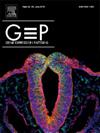Molecular basis and key biological processes for myocardial regeneration: Transcriptomic analysis of acute myocardial infarction in a translational ovine model
IF 1.1
4区 生物学
Q4 DEVELOPMENTAL BIOLOGY
引用次数: 0
Abstract
Background
Recently, transcriptomic analysis has been key in identifying therapeutic targets in cardiovascular regeneration. The postnatal loss of cardiomyocyte proliferative capacity has been linked to the transition from glycolysis to fatty acid oxidation in rodent models of acute myocardial infarction (AMI). However, the transcriptomic profile of these processes in large mammals more similar to humans is still unknown. The aim of this study was to examine the transcriptomic profile, from the proliferative fetal stage to the non-regenerative infarcted adult stage, in an ovine AMI model.
Methods
Samples consisted of fetal sheep hearts sequenced in our laboratory and adult sheep hearts (healthy, infarct, and infarct border) from the Gene Expression Omnibus repository (GSE164245).
Results
Fetal tissue showed changes in epigenetic regulation and a predominance of glycolytic metabolism, whereas in the adult infarct core and border zones, there was a partial activation of glycolysis and a reduction in the expression of genes associated with β-oxidation of fatty acids. Myocardial infarction in adult sheep triggers metabolic changes that partially mimic fetal regenerative processes.
Conclusions
These findings will allow for a more precise understanding of the mechanisms underlying cardiac regeneration and facilitate the translation of regenerative therapies for clinical application in humans.
心肌再生的分子基础和关键生物学过程:翻译羊模型急性心肌梗死的转录组学分析。
背景:最近,转录组学分析已成为确定心血管再生治疗靶点的关键。在啮齿动物急性心肌梗死(AMI)模型中,出生后心肌细胞增殖能力的丧失与糖酵解向脂肪酸氧化的转变有关。然而,在与人类更相似的大型哺乳动物中,这些过程的转录组学特征仍然未知。本研究的目的是在绵羊AMI模型中检查从增殖胎儿期到非再生梗死成年期的转录组谱。方法:样本包括在我们实验室测序的胎羊心脏和来自基因表达综合库(GSE164245)的成年羊心脏(健康、梗死和梗死边界)。结果:胎儿组织表现出表观遗传调控的变化和糖酵解代谢的优势,而在成人梗死核心和边界区,糖酵解的部分激活和与脂肪酸β-氧化相关基因的表达减少。成年羊心肌梗死触发代谢变化,部分模仿胎儿再生过程。结论:这些发现将有助于更精确地理解心脏再生的机制,并促进再生疗法在人类临床应用中的转化。
本文章由计算机程序翻译,如有差异,请以英文原文为准。
求助全文
约1分钟内获得全文
求助全文
来源期刊

Gene Expression Patterns
生物-发育生物学
CiteScore
2.30
自引率
0.00%
发文量
42
审稿时长
35 days
期刊介绍:
Gene Expression Patterns is devoted to the rapid publication of high quality studies of gene expression in development. Studies using cell culture are also suitable if clearly relevant to development, e.g., analysis of key regulatory genes or of gene sets in the maintenance or differentiation of stem cells. Key areas of interest include:
-In-situ studies such as expression patterns of important or interesting genes at all levels, including transcription and protein expression
-Temporal studies of large gene sets during development
-Transgenic studies to study cell lineage in tissue formation
 求助内容:
求助内容: 应助结果提醒方式:
应助结果提醒方式:


